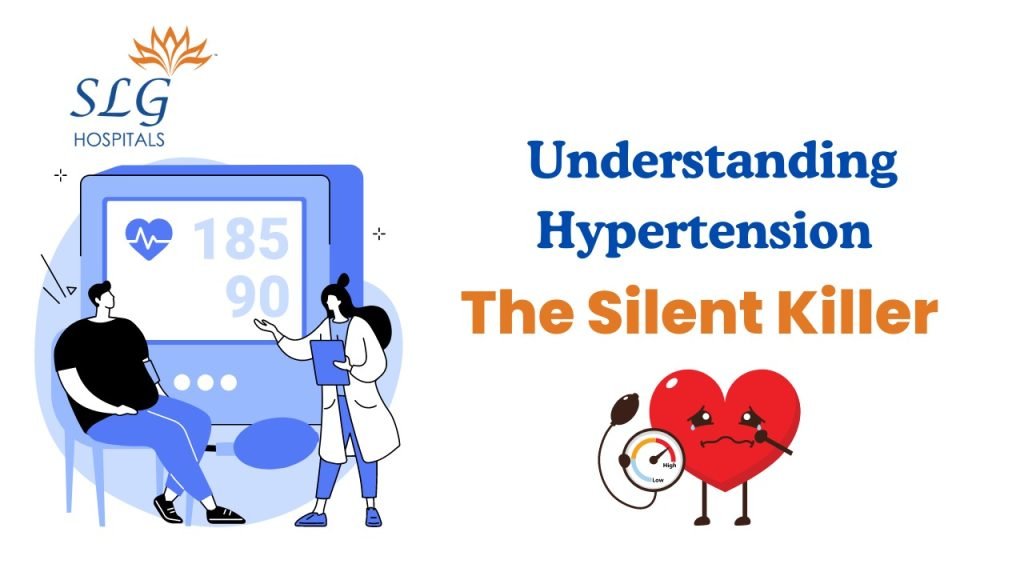Understanding Hypertension: The Silent Killer

Hypertension, commonly known as high blood pressure, is often referred to as the “silent killer.” This is because it typically has no symptoms but can lead to serious health problems such as heart disease, stroke, and kidney failure if left untreated.
According to the World Health Organization (WHO), an estimated 1.13 billion people worldwide have hypertension, making it a leading cause of premature death globally. Understanding the causes, risks, prevention, and management of hypertension is crucial for maintaining cardiovascular health and overall well-being.
This blog is by a Cardiology Specialist at SLG Hospitals, Bachupally. Who can help manage and Understand hypertension and treat it through medication, lifestyle changes, and diet
What is Hypertension?

Blood pressure is the force exerted by circulating blood on the walls of the body’s arteries, the major blood vessels in the body. Hypertension occurs when this pressure is consistently too high. Blood pressure is measured in millimeters of mercury (mmHg) and recorded with two numbers: systolic pressure (the pressure in your arteries when your heart beats) over diastolic pressure (the pressure in your arteries when your heart rests between beats). A normal blood pressure reading is typically around 120/80 mmHg. Hypertension is diagnosed when readings are consistently 140/90 mmHg or higher.
Causes of Hypertension

The exact causes of hypertension are often not clear, but several factors can contribute to its development.
- Genetics: A family history of hypertension increases the risk.
- Age: Blood pressure tends to increase with age.
- Obesity: Excess body weight can increase the strain on the heart.
- Sedentary Lifestyle: Lack of physical activity contributes to weight gain and hypertension.
- Diet: High salt intake, low potassium, and excessive alcohol consumption can raise blood pressure.
- Stress: Chronic stress may contribute to hypertension.
- Medical Conditions: Conditions such as diabetes, kidney disease, and sleep apnea are linked to higher blood pressure.
Symptoms and Risks
Hypertension is often asymptomatic, which is why regular screening is important. However, in severe cases or hypertensive crises, individuals may experience symptoms such as:
- Severe headaches
- Shortness of breath
- Nosebleeds
- Chest pain
- Vision problems
- Fatigue or confusion
- Untreated hypertension can lead to serious complications
- Heart Disease: Hypertension increases the risk of coronary artery disease, heart failure, and myocardial infarction (heart attack).
- Stroke: High blood pressure can lead to a stroke by damaging and weakening brain blood vessels, causing them to narrow, rupture, or leak.
- Kidney Damage: Hypertension can damage the blood vessels in the kidneys, leading to kidney failure.
- Vision Loss: High blood pressure can cause blood vessels in the eyes to burst or bleed, leading to vision problems.
- Aneurysm: Increased blood pressure can cause blood vessels to weaken and bulge, forming an aneurysm that can potentially rupture and be life-threatening.
Prevention and Management

Preventing and managing hypertension involves lifestyle changes and, in some cases, medication. Here are some effective strategies:
Lifestyle Changes
- Healthy Diet: Reduce Salt Intake: Limiting sodium can help lower blood pressure. The WHO recommends consuming less than 5 grams of salt per day.
- Increase Potassium: Potassium-rich foods like bananas, oranges, and spinach help balance blood pressure.
- Eat a Balanced Diet: Focus on a diet rich in fruits, vegetables, whole grains, and lean proteins. The DASH (Dietary Approaches to Stop Hypertension) diet is specifically designed to help manage blood pressure.
Regular Exercise:
Aim for at least 150 minutes of moderate aerobic activity or 75 minutes of vigorous activity each week.
Include muscle-strengthening activities on two or more days a week.
Maintain a Healthy Weight:
Achieving and maintaining a healthy weight can significantly lower blood pressure.
Even a small amount of weight loss can make a big difference.
Limit Alcohol Consumption:
Men should have no more than two drinks per day, and women should have no more than one drink per day.
Quit Smoking:
Smoking increases blood pressure and the risk of heart disease.
Quitting smoking can improve overall cardiovascular health.
Manage Stress:
Techniques such as deep breathing, meditation, yoga, and progressive muscle relaxation can help reduce stress and lower blood pressure.
Medication
Medications may be prescribed when lifestyle changes are not enough to control blood pressure. These can include:
- Diuretics: Help the kidneys remove sodium and water, reducing blood volume.
- ACE Inhibitors: Relax blood vessels by blocking the formation of a natural chemical that narrows blood vessels.
- Calcium Channel Blockers: Help relax blood vessels by preventing calcium from entering the cells of the heart and blood vessel walls.
- Beta-Blockers: Reduce the workload on the heart and open up blood vessels, causing the heart to beat slower and with less force.
Regular Monitoring
Regular monitoring of blood pressure is crucial for those with hypertension or at risk of developing it. Home blood pressure monitors can be useful for tracking readings between doctor visits. Keeping a record of these readings can help healthcare providers adjust treatment plans accordingly.
Hypertension is a major global health concern due to its role in increasing the risk of heart disease, stroke, and other serious health issues. Despite its often silent nature, hypertension is manageable and preventable through a combination of lifestyle changes, regular monitoring, and medication when necessary. By adopting healthy habits and staying informed about their blood pressure, individuals can significantly reduce their risk and lead healthier, longer lives. Regular check-ups with healthcare providers are essential to monitor and manage blood pressure effectively















